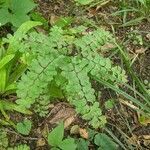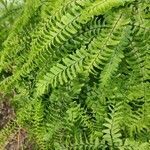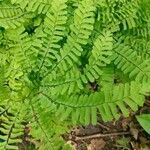Rhizome short-creeping, 3–5 mm thick, its scales light brown, 3–6 × 1–2 mm; lvs few or solitary, with an erect, purple or purplish-black petiole 1–6 dm, the blade shorter and set nearly at right angles to the petiole, mostly 1–4 dm long and about as wide, or wider, reniform-orbicular when well developed, subequally forked at the top of the petiole into 2 recurved-spreading rachises that bear 2–several progressively shorter pinnae along the outside of the curve; larger pinnae with mostly 15–35 alternate, short-stalked, widely spreading pinnules on each side of the costa; pinnules 12–22 × 5–9 mm, obliquely oblong, the midrib near the lower margin, which is entire and straight or concave, the upper (distal) margin more convex, lobulate, and bearing the oblong indusial flaps; 2n=58, 116. Moist Woods and streamsides in circumneutral soil, and on serpentine slopes at scattered stations from Nf. to Vt.; Nf. to Alas. and adj. Asia, s. to Ga., La., Okla., and Calif. Most e. Amer. plants belong to the nomenclaturally typical phase of the sp.; serpentine plants from both e. and w. N. Amer. tend to have fewer and smaller pinnae and have been segregated as subsp. calderi Cody.
Stems short-creeping; scales bronzy deep yellow, concolored, margins entire. Leaves lax-arching (rarely pendent), closely spaced, 40--75 cm. Petiole 1--2 mm diam., glabrous, occasionally glaucous. Blade fan-shaped, pseudopedate, 1-pinnate distally, 15--30 × 15--35 cm, glabrous; proximal pinnae 3--9-pinnate; rachis straight, glabrous, occasionally glaucous. Segment stalks 0.5--1.5(--1.7) mm, dark color entering into segment base. Ultimate segments oblong, ca. 3 times as long as broad; basiscopic margin straight; acroscopic margin lobed, lobes separated by narrow incisions 0--0.9(--1.1) mm wide; apex obtuse, divided into shallow, rounded lobes separated by shallow sinuses 0.1--2(--3.7) mm deep, margins of lobes crenulate or crenate-denticulate. Indusia transversely oblong, 1--3 mm, glabrous. Spores mostly 34--40 µm diam. 2 n = 58.
A fern. It grows 40-60 cm tall. It forms clumps.



